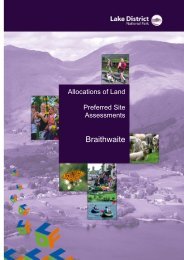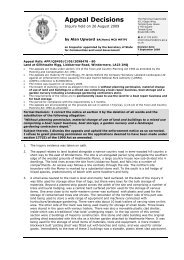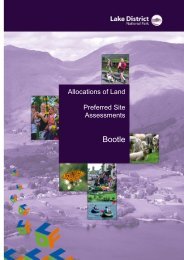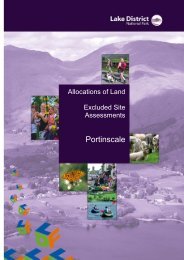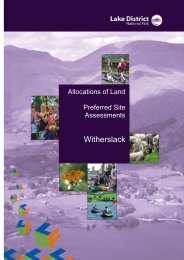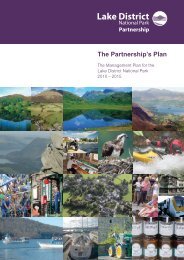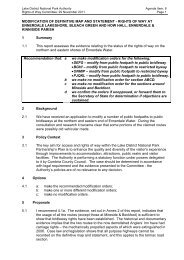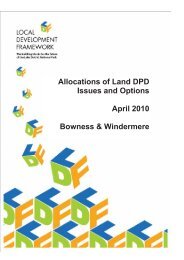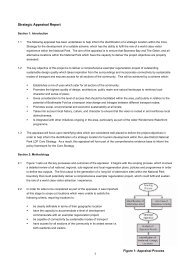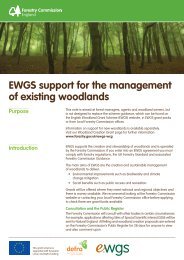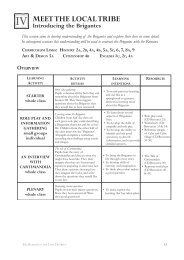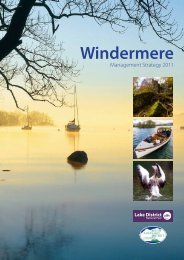Conversions practice guide (PDF - Lake District National Park
Conversions practice guide (PDF - Lake District National Park
Conversions practice guide (PDF - Lake District National Park
Create successful ePaper yourself
Turn your PDF publications into a flip-book with our unique Google optimized e-Paper software.
v<br />
Practice guidance: <strong>Conversions</strong><br />
How do we approach planning applications for conversion in the open countryside?<br />
www.lakedistrict.gov.uk<br />
January 2013
Practice guidance: The conversion of buildings in the open countryside<br />
What is <strong>practice</strong> guidance?<br />
This guidance sets out our <strong>practice</strong> approach to proposals for the conversion of buildings in the open<br />
countryside. It is one of a series of guidance notes that respond to customer feedback. It is not planning<br />
policy, which can be found elsewhere on our website.<br />
This <strong>practice</strong> guidance sets out:<br />
• our policies<br />
• national policies<br />
• our approach to making decisions<br />
What is the policy context?<br />
The Vision for the <strong>Lake</strong> <strong>District</strong> <strong>National</strong> <strong>Park</strong> is that it will be an inspirational example of sustainable<br />
development in action.<br />
Our planning policies were adopted as part of our Local Development Framework (LDF) Core Strategy in<br />
October 2010.<br />
Government published the <strong>National</strong> Planning Policy Framework (NPPF) in March 2012.<br />
What do our LDF policies say?<br />
Achieving vibrant and sustainable settlements<br />
LDF Policy CS02: achieving vibrant and sustainable settlements, states that development should be of a scale<br />
and nature appropriate to the character and function of the location in which it is proposed, meeting needs<br />
or bringing benefits to the local community or delivering sustainable tourism.<br />
Policy CS02 identifies rural service centres, villages, cluster communities and open countryside. Policy<br />
supports conversions in rural service centres, villages and clusters, in principle.<br />
Policy CS02 states exceptionally, we will only support development in the open countryside where it<br />
demonstrates an appropriate reuse, redevelopment or extension of an existing building.<br />
The policy and the explanatory text do not advise on what amounts to the appropriate reuse or<br />
redevelopment of an existing building. Site specific considerations and Policy CS11 have been used to inform<br />
our approach.<br />
Sustainable development principles<br />
Policy CS11: sustainable development principles, states that we want all development to be designed and<br />
carried out in a way that avoids adverse effects on the special qualities of the <strong>National</strong> <strong>Park</strong> and applies the<br />
principles of sustainable development. This policy sets out nine requirements including reducing people’s<br />
need to travel, by demonstrating that the development is accessible by cycling, walking or public transport.<br />
These are aims for sustainable development and as they apply to all types of development a flexible approach<br />
is required.<br />
What does the <strong>National</strong> Planning Policy Framework say?<br />
Since the Government published the NPPF in March 2012 it constitutes a material consideration in<br />
determining applications.
NPPF: Sustainable development and the need to travel<br />
At the heart of the NPPF is a presumption in favour of sustainable development, recognising the economic,<br />
social and environmental role of the planning system. Paragraphs 18 to 219, taken as whole, constitute the<br />
Government’s view of what sustainable development means in <strong>practice</strong> for the planning system.<br />
In promoting sustainable transport Government recognises that different policies and measures will be<br />
required in different communities and opportunities to maximise sustainable transport solutions will vary<br />
from urban to rural areas (paragraph 29).<br />
In preparing Local Plans, local planning authorities should support a pattern of development which, where<br />
reasonable to do so, facilitates the use of sustainable modes of transport (paragraph 30).<br />
The NPPF requires us to ensure that developments which generate significant movement are located where<br />
the need to travel will be minimised and the use of sustainable transport modes can be maximised. It goes<br />
on to say this needs to take account of policies set out elsewhere in the NPPF, particularly in rural areas<br />
(paragraph 34).<br />
NPPF: Housing in rural areas – conversions in the countryside<br />
The NPPF states that to promote sustainable development in rural areas, housing should be located where<br />
it will enhance or maintain the vitality of rural communities. The NPPF also confirms that Local Planning<br />
Authorities should avoid new isolated homes in the countryside unless there are special circumstances. One<br />
of these special circumstances is where the development ‘would re-use redundant or disused buildings and<br />
lead to an enhancement to the immediate setting’. Another circumstance is where ‘such development would<br />
represent the optimal viable use of a heritage asset or would be appropriate enabling development to secure<br />
the future of heritage assets’ (paragraph 55).<br />
Home on the Farm<br />
Since October 2010 Home on the Farm is Government policy. This encourages the conversion of buildings in<br />
the countryside to affordable homes for local people.<br />
What is our approach to making decisions?<br />
The NPPF (paragraph 55) supports the re-use of redundant or disused buildings in the countryside as homes<br />
where this would lead to an enhancement to the immediate setting. This policy is part of the Government’s<br />
view on what sustainable development means and is consistent with those paragraphs of the NPPF that<br />
cover sustainable transport in rural areas. We use the NPPF alongside our policies and other material planning<br />
considerations to decide on the appropriateness of a proposed conversion.<br />
To enable a consistent approach to the implementation of Policy CS02 of the LDF Core Strategy in respect of<br />
the conversion of buildings in the open countryside we recognise the terms in which the NPPF supports the<br />
re-use of redundant or disused buildings in the countryside as homes and take the following approach:
What questions will we ask when we assess a conversion proposal?<br />
The key question we will ask when we assess applications for the conversion of buildings is<br />
“Does the proposal represent an appropriate reuse which would contribute towards achieving<br />
sustainable development?”<br />
In order to answer this question we will consider a number of factors which, amongst other things, may<br />
include:<br />
• How well related is the site to identified settlements, services and sustainable transport connections?<br />
• Would the proposal lead to an enhancement of the immediate setting of the building?<br />
• Would the development secure the future of a heritage asset?<br />
• Is the building structurally sound?<br />
• Would the development require major extensions or alterations?<br />
• Is the design appropriate?<br />
• Would the development affect protected species?<br />
• Would the development affect trees?<br />
• Are access arrangements acceptable?<br />
• Would the amenity of other properties be affected?<br />
Frequently asked questions...<br />
What factors might we consider when deciding whether the development is well related to settlements,<br />
services and sustainable transport connections?<br />
We consider this by taking account of our policies and material planning considerations.<br />
Our policies that are likely to be relevant include:<br />
• Policy CS02 achieving vibrant and sustainable settlements<br />
• Policy CS11 sustainable development principles<br />
• Policy CS14 sustainable transport<br />
Material planning considerations may include:<br />
• how far is the building from settlements, services and sustainable transport connections?<br />
• could the development be meaningfully and safely accessed by non-car travel?<br />
We will:<br />
• look less favourably on proposals which are isolated or remote from settlements, services and sustainable<br />
transport connections (compared to proposals in highly accessible locations).<br />
Why must the building be structurally sound?<br />
Policy CS02 and the <strong>National</strong> Planning Policy Framework strictly control new build housing development in<br />
the open countryside. <strong>Conversions</strong> are only permitted on the basis that the building is capable of conversion<br />
without rebuilding. In cases where a building is not structurally sound and capable of conversion without<br />
rebuilding, we will not normally support a scheme. If there is doubt about the structural condition of the<br />
building, we may require a structural survey to be provided.<br />
What factors might we consider when deciding whether the building makes a positive contribution to the
landscape and whether the development would lead to an enhancement of the immediate setting?<br />
We consider this by taking account of our policies and material planning considerations.<br />
Our policies that are likely to be relevant include:<br />
• Policy CS10 achieving design excellence<br />
• Policy CS25 protecting the spectacular landscape<br />
• Policy CS27 the acclaimed historic environment<br />
• Policy BE13 alterations and extensions to listed buildings<br />
• Policy C7 requirements for all conversions (Saved Local Plan policy)<br />
Material planning considerations may include:<br />
• how does the building relates to it’s landscape setting and what changes would result from conversion?<br />
• what is the landscape character – tranquillity, remoteness and wildness are more relevant than simply<br />
distance from settlements<br />
• is the proposal of a scale and nature appropriate to the character of the location?<br />
• what is the size, appearance, character, condition, and heritage of the building and how would the<br />
proposal affect these?<br />
• would the development secure the future of a building which makes a positive contribution to the<br />
landscape?<br />
• how does the building relate to other buildings and landscape features?<br />
We will:<br />
• take account of the high quality of the landscape and its sensitivity to change<br />
• base our assessment on the resulting enhancement and not simply the quality of the existing building<br />
• ensure proposals are well related to settlement pattern, existing houses and buildings, and are not truly<br />
isolated or remote<br />
• take particular interest in the circumstances if the building has only recently been constructed for another<br />
purpose<br />
Is there anything else to be aware of?<br />
Housing: The LDF Core Strategy has a priority for local needs and local affordable needs housing. All<br />
permissions will be in line with Policy CS18 housing provision and our Supplementary Planning Document –<br />
occupancy controls will be used.<br />
Employment: Buildings may be suitable for conversion to employment uses in accordance with Policy CS22<br />
employment.<br />
Holiday letting: We will only permit holiday letting in accordance with Policy CS22a reuse of buildings for<br />
holiday letting accommodation. The circumstances in which a building may be not suitable for permanent<br />
accommodation will usually be site specific, for example lack of amenity or within a holiday complex.
Contact us<br />
<strong>Lake</strong> <strong>District</strong> <strong>National</strong> <strong>Park</strong> Authority<br />
Murley Moss Business <strong>Park</strong><br />
Oxenholme Road<br />
Kendal<br />
LA9 7RL<br />
Telephone: 01539 724555<br />
Fax: 01539 740822<br />
Minicom: 01539 792690<br />
Email: planning@lakedistrict.gov.uk<br />
www.lakedistrict.gov.uk<br />
A duty planning officer is available Monday<br />
to Friday between 9.30am and 12.30pm<br />
to talk to either by phone or in person at<br />
our Kendal offices. We also run planning<br />
surgeries in Keswick, Glenridding and<br />
Gosforth where you can meet an officer in<br />
person. Please see our website or call us for<br />
details of surgery times and locations.<br />
We will update our Practice Guidance on<br />
the basis of experience. If you have any<br />
views on our guidance please let us know<br />
at planning@lakedistrict.gov.uk



